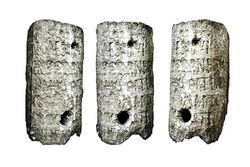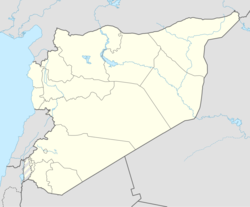ريساينا
Rhesaina | |
 Roman Heavy Infantryman. Battle of Rhesaina, Mesopotamia, AD 243 | |
| المكان | سوريا |
|---|---|
| المنطقة | محافظة الحسكة |
| الإحداثيات | 36°51′01″N 40°04′14″E / 36.8503°N 40.0706°E |
| التاريخ | |
| الثقافات | الرومانية |
| ملاحظات حول الموقع | |
| الحالة | أطلال |
| الاتاحة للعامة | Yes |
ريساينا ( Rhesaina ؛ Rhesaena) (باليونانية قديمة: Ρέσαινα and Ρεσαίνα)[1] or Resina (Ῥέσινα)[2] كانت مدينة في المقاطعة الرومانية المتأخرة ميزوپوتاميا سـِكوندا و أسقفية that was a suffragan of Dara.[3]
ريساينا Rhesaina (Rhesaena, Resaena – تنويعات عديدة تظهر للاسم في الكتب القديمة) كانت بلدة مهمة في الطرف الشمالي لـبلاد الرافدين، بالقرب من منابع الخوبراس (هو الآن نهر الخابور. وكانت في الطريق من حران إلى نقفوريوم، على بعد نحو 120 كيلومتر من نصيبين و 64 كم من دارا. وبالقرب منها، قاتل الإمبراطور گورديان الثالث الساسانيين الفرس في عام 243، في معركة ريساينا. وهي الآن رأس العين، سوريا.
Its coins show that it was a Roman colony from the time of سپتيميوس سڤروس. The Notitia Dignitatum (ed. Boecking, I, 400) represents it as under the jurisdiction of the governor or Dux of Osrhoene. Hierocles (Synecdemus, 714, 3) also locates it in this province but under the name of Theodosiopolis (Θεοδοσιούπολις); it had in fact obtained the favour of ثيودوسيوس الأكبر وأخذت اسمه. وقد حصّنها جستنيان. وفي 1393 دمرتها، بشكل شبه كامل، قوات تيمورلنك.
لقى الحضر
 Composed image of the milestone from Karsi، شمال العراق، rediscovered by the author in متحف أربيل للحضارات (كردستان العراق). Photo and graphic elaboration by R. Palermo. |
There are also three Latin inscription from Hatra, a Parthian holy city in northwestern Iraq, that suggest a temporary Roman military presence in the Sun-God city, which was otherwise never fully integrated in the Roman administration of Mesopotamia and ultimately conquered by the Sasanians in the first half of the 3rd century CE.[4]
The archaeological data in our hands is far from satisfactory and political instability further hinders archaeological exploration in the area at present. Even so, recent investigations in the Kurdistan Region of Iraq, East of the Tigris (and thus beyond the limes) are substantially rewriting the traditional narrative of Mesopotamia as a war-torn area between the Empires at the beginning of the 1st millennium CE, highlighting how the Parthian-period occupation of the extended region East of Tigris experienced a considerable demographic growth despite the political turmoil. This was possibly due to a limited interference of the Roman miliary operations in the area, and to the pivotal role of the local dynasty of Adiabene, a vassal-state of the Parthian Empire, that controlled the region immediately to the east of the Tigris, which is from where this short journey through Roman period Mesopotamia has begun.
الأساقفة
Rhesaina was also the site of a Bishopric. The Diocese of Rhesaina is today a suppressed and titular see of the Roman Catholic Church in the episcopal province ميزوپوتاميا
Le Quien[5] mentions nine bishops of Rhesaena:
الأساقفة الرومان
- Antiochus, present at the First Council of Nicaea (325);
- Eunomius, who (about 420) forced the Persians to raise the siege of the town;
- John, at the Council of Antioch (444);
- Olympius, at the Council of Chalcedon (451);
- Andrew (about 490);
- Peter, exiled with Sevenian (518);
- Ascholius, his successor, a Monophysite;
- Daniel (550);
- Sebastianus (حوالي 600)، مراسل گريگوري الأكبر.
العصور الوسطى
The see is again mentioned in the 10th century in a Greek Notitia episcopatuum of the Patriarchate of Antioch (Vailhé, in "Échos d'Orient", X, 94). Le Quien (ibid., 1329 and 1513) mentions two Jacobite bishops: Scalita, author of a hymn and of homilies, and Theodosius (1035). About a dozen others are known.
الأساقفة الكاثوليك
- Joseph-Louis Coudé,(15 Jan 1782 Appointed – 8 Jan 1785)[6]
- Alexander MacDonell (12 Jan 1819 Appointed – 27 Jan)
- Antonio Maria de J. Campos Moreno (19 Dec 1834 – 12 Jan 1851)
- Francis McNeirny (22 Dec 1871 – 12 Oct 1877
- Tommaso Bichi (16 Dec 1880 – 1901)
- Domenico Scopelliti (15 Dec 1919 – 16 Apr 1922)
- Vicente Huarte y San Martín (26 Apr 1922 – 23 Aug 1935)
- Joseph Gjonali (Gionali) (30 Oct 1935 – 20 Dec 1952)
- Gerardo Valencia Cano, (24 Mar 1953 – 21 Jan 1972)
المراجع
- ^ Claudius Ptolemaeus, Geographia, p.108
- ^ Harry Thurston Peck, Harpers Dictionary of Classical Antiquities (1898), Resaina
- ^ Annuario Pontificio 2013 (Libreria Editrice Vaticana, 2013, ISBN 978-88-209-9070-1), p. 958]
- ^ Rocco Palermo (2024-10-01). "The Land at the End of the Empire: The Roman Eastern Border in Mesopotamia". ANE Today.
- ^ Oriens christianus, II, 979.
- ^ Rhesaina at catholic-hierarchy.org.
- ذِكرها
 هذه المقالة تضم نصاً من مطبوعة هي الآن مشاع: هربرمان, تشارلز, ed. (1913). . الموسوعة الكاثوليكية. Robert Appleton Company.
هذه المقالة تضم نصاً من مطبوعة هي الآن مشاع: هربرمان, تشارلز, ed. (1913). . الموسوعة الكاثوليكية. Robert Appleton Company. {{cite encyclopedia}}: Cite has empty unknown parameters:|1=,|coauthors=, and|month=(help); Invalid|ref=harv(help) The entry cites:- Revue de l'Orient chrét. VI (1901), 203;
- D'Herbelot, Bibl. orientale, I, 140; III, 112;
- Carl Ritter, Erdkunde, XI, 375;
- William Smith, Dictionary of Greek and Roman Geography, s. v., with bibliography of ancient authors;
- Müller, notes on Ptolemy, ed. Didot, I, 1008;
- Chapot, La frontière de l'Euphrate de Pompée à la conquête arabe (Paris, 1907). 302.
- Pages using gadget WikiMiniAtlas
- Short description is different from Wikidata
- Articles containing Ancient Greek (to 1453)-language text
- Articles incorporating text from the 1913 Catholic Encyclopedia with Wikisource reference
- Coordinates on Wikidata
- Catholic titular sees in Asia
- بلدات ومدن رومانية في سوريا
- أماكن مأهولة في الإمبراطورية البيزنطية
- أماكن مأهولة في محافظة الحسكة
- Coloniae (Roman)
